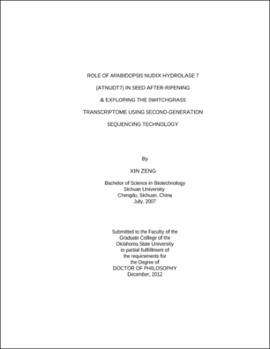| dc.contributor.advisor | Mahalingam, Ramamurthy | |
| dc.contributor.author | Zeng, Xin | |
| dc.date.accessioned | 2013-11-26T08:23:01Z | |
| dc.date.available | 2013-11-26T08:23:01Z | |
| dc.date.issued | 2012-12 | |
| dc.identifier.uri | https://hdl.handle.net/11244/6687 | |
| dc.description.abstract | Scope and Method of Study: | |
| dc.description.abstract | In this study the role of Arabidopsis nudix hydrolase 7 in seed after-ripening was analyzed. Techniques include cloning, transgenics, seed physiology assays, enzyme cycling assays, fluorometry, spectophotometry, mass spectrometry, GUS staining, microscopy, real-time PCR, western analysis, recombinant proteins, and electrophoretic mobility shift assay. In another study 454 sequencing was used to examine switchgrass transcriptome. Techniques include RNA isolations, affinity depletion, cDNA library preparation, 454 pyrosequencing, de novo and reference genome based sequence assembly, comparative genomics, reverse transcription PCR, in silico prediction of EST-SSRs, proxy methods for estimating transcriptome coverage. | |
| dc.description.abstract | Findings and Conclusions: | |
| dc.description.abstract | Loss of Arabidopsis nudix hydrolase 7 (AtNudt7-1) reduces seed germination potential. AtNUDT7 protein levels are required in dry seeds and during early hours following imbibition to realize maximum seed germination potential. Loss of AtNUDT7 impairs seed after-ripening mainly through pertubations in NAD:NADH balance, that in turn affect phytohormones and oxidative signaling pathways. Manipulating levels of NUDT7 will provide a novel avenue for overcoming seed dormancy and maximizing germination potential of seeds. | |
| dc.description.abstract | Approximately 980,000 EST sequences averaging 367 bp were generated from dormant seeds, seedlings, tillers and flowers of switchgrass using 454 based pyrosequencing. Using foxtail millet genome as a reference, greatly improved the assembly and annotation of switchgrass ESTs. It is estimated that nearly 90% of the gene space of switchgrass was identified based on ESTcalc, coverage of ultraconserved orthologs and planttribes, and genes in C4 photosynthesis pathway. This study more than doubles the current publicly available switchgrass ESTs. Next generation sequencing technologies provides a viable alternative to whole genome sequencing of polyploids like switchgrass. | |
| dc.format | application/pdf | |
| dc.language | en_US | |
| dc.rights | Copyright is held by the author who has granted the Oklahoma State University Library the non-exclusive right to share this material in its institutional repository. Contact Digital Library Services at lib-dls@okstate.edu or 405-744-9161 for the permission policy on the use, reproduction or distribution of this material. | |
| dc.title | Role of Arabidopsis nudix hydrolase 7 (AtNudt7) in seed after-ripening and exploring the switchgrass transcriptome using second-generation sequencing technology | |
| dc.contributor.committeeMember | Mort, Andrew | |
| dc.contributor.committeeMember | Hoyt, Peter | |
| dc.contributor.committeeMember | Wu, Yanqi | |
| osu.filename | Zeng_okstate_0664D_12282.pdf | |
| osu.accesstype | Open Access | |
| dc.type.genre | Dissertation | |
| dc.type.material | Text | |
| dc.subject.keywords | arabidopsis | |
| dc.subject.keywords | atnudt7 | |
| dc.subject.keywords | dormancy | |
| dc.subject.keywords | pyridine nucleotide | |
| dc.subject.keywords | switchgrass | |
| dc.subject.keywords | transcriptomes | |
| thesis.degree.discipline | Biochemistry and Molecular Biology | |
| thesis.degree.grantor | Oklahoma State University | |
